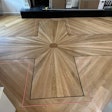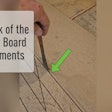Q . I recently installed 900 square feet of wood flooring in a home, and now the customer thinks that the joints are too close together. What is the best way to rack a floor?
A . Racking a hardwood floor is a craft in itself. Proper placement of each piece makes all the difference in making a wood floor look beautiful.
Whether strip or plank, engineered or solid, wood floors' racking does make a difference in the appearance and performance of a wood floor system. Always follow manufacturers' recommendations. To start with, plan ahead. Place bundles or boxes of flooring with the tongue facing in the direction that the flooring is being installed. This will help you place the boards on the floor a lot quicker, since you won't have to turn each one around as you're racking. Also remember to put aside longer pieces of flooring for your starting areas and ending areas. That makes for a more uniform appearance and is easier to work with. Use your flooring wisely throughout the process, using long lengths as well as shorts when racking. One of the biggest complaints that I hear from general contractors and customers is that there are too many joints along the walls or in a small area.
When installing 1 1/2-, 2- and 2 1/4-inch tongue-and-groove flooring, end joints should be staggered 6 to 8 inches apart. Use good judgment, not allowing H joints, stair steps and clusters of joints. Once the floors are finished, areas with such joints will be noticeable. When installing nail-down shorts, it is extremely difficult to prevent H joints, stair steps and clusters of joints. This should be explained to the customer up front, before the job is started.
Plank flooring takes a different approach when racking. The wider the plank, the more distance there should be between the end joints. For example, if you space joints 6 to 8 inches apart when installing a 3-, 5- and 7-inch plank floor, you will have a lot of joints very close together in a hurry. Spacing the joints 10 to 12 inches or more apart makes for a nicer looking floor, especially if the floor will have pegs in it.
Installing prefinished and unfinished engineered products also takes time and effort. With these products, some of your longest lengths are approximately 48 inches and less. It's easy to get caught off guard and allow joints to stack up. Again, take the time to rack or lay out the floor accordingly. If the flooring is a glue-down product, installation may take more time. Selecting the proper length as you install makes work easier than putting a piece in and realizing a few runs later that it has to be pulled back out. That can be a messy situation.
Whatever flooring you are installing, take a good look at each piece as you are racking and cull out the ones that are very distinguished in the grain and/or color. These pieces may not be bad or defective, but they will look different from the rest of the floor. Some customers may pick one board out of 1,000 square feet of flooring and want that board repaired or replaced. It is a good business practice to explain to the customer the differences in colors and finish (for prefinished floors) and grades and cuts (for both unfinished and prefinished products). For engineered flooring, you'll need to explain the difference between a peeled or sawn face, while solid products vary between plain-, rift- and quartersawn boards.
Some floating floors or longstrip products are made up of short pieces on the face of the flooring. There are a lot of joints that are close together. Even though the products are 7 1/2 to 8 inches wide and 8 feet long, they still need to have proper placement of the end joints to avoid H joints, stair steps and clusters. Remember to follow manufacturers' recommendations on racking, layout and nailing schedule (or adhesive and trowel).
Remember that people who hire you to do the job put their trust in you to install the wood floor in a professional manner. Always take the time to inspect the floor before you take the final step of nailing, stapling or gluing it in place.

































